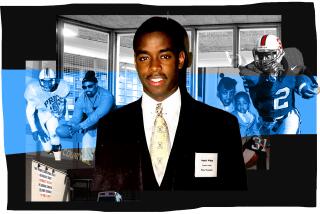Sloan Wilson, 83; Wrote ‘Man in the Gray Flannel Suit’
- Share via
Sloan Wilson, author of the bestselling 1955 novel whose title, “The Man in the Gray Flannel Suit,” became a catch-phrase to describe frustrated suburbanites striving for the illusive and ever-more-expensive American Dream, has died. He was 83.
Wilson died Sunday in Colonial Beach, Va., after suffering from Alzheimer’s disease. He had lived on a boat in the sailing community for many years.
Although Wilson wrote more than a dozen novels and many articles for such magazines as the New Yorker, Harper’s, Reader’s Digest and Life, “The Man in the Gray Flannel Suit” was his greatest -- and perhaps only -- true success.
The book became a sensation and sold more than 2 million copies. It was often reprinted over the years and has remained a staple of sociology as well as literature classes.
The novel was quickly turned into a 1956 motion picture written and directed by Nunnally Johnson and starring Gregory Peck and Jennifer Jones as the novel’s suburban couple, Tom and Betsy Rath.
Tom Rath, who had been a paratrooper and experiences frequent flashbacks from World War II, commutes from Westport, Conn., to his New York City job at a charitable foundation, fretting about how to pay for repairs on a rundown house, a new car, private schools for three children and the demands of his social-climbing wife. He takes a public relations job in a broadcasting company to earn money and becomes engulfed in hypocrisy and the easy answer.
“The novel captured and bottled a floating anxiety, a sour malaise, that belied the [1950s] peppy froth of Patti Page records and TV jingles,” wrote James Wolcott in reviewing the latest edition of the book for The Times in 2002. “The writing is vigorous, unvarnished, tartly observant; its overhanging disquietude isn’t dated -- if anything, it’s deepened.”
The prescribed uniform of the day -- the gray flannel suit -- is only one connection hero Rath makes between the military hierarchy and corporate bureaucracy, along with demanding CEOs as generals and wealth as the ultimate victory.
The book’s title became a metaphor for the upper-middle class, an epithet for a corporate cipher adhering to dress and behavioral codes.
The novel had its critics, particularly Time magazine, which called it an “upper-middle-class soap opera.” But its greatness may lie in that it can still spark meaningful discussions over quality of life versus monetary success almost half a century after it was written.
Wilson’s own recognition of the book as his greatest triumph is evident in two others he wrote -- “The Man in the Gray Flannel Suit II,” a 1984 sequel that fared poorly, and the better-received, autobiographical “What Shall We Wear to This Party: The Man in the Gray Flannel Suit Twenty Years Before and After.”
The author also earned attention with his 1958 novel, “A Summer Place,” which became a 1959 film starring teen heartthrobs Sandra Dee and Troy Donahue and is best remembered for its theme song.
Generally, critics praised Wilson’s talent and ability to write highly readable books, but disparaged his characters and plots, oversimplification and the repetitive theme of conformity.
Wilson said that he never thought about conformity, that he wrote about his own life and the things that afflict people like him -- jobs, money, social climbing, divorce, alcoholism and nervous breakdowns.
Indeed, much of Wilson’s background was woven into his books. Many were set in Westport, Conn., where he was born one of three children of two writers. Several were based on his expertise as a sailor living along the Atlantic and serving in the Coast Guard during World War II. (His first published work, a poem called “Soldiers Who Sit,” was published in the New Yorker while he was still in uniform.)
Wilson’s “Gray Flannel” echoed many of his problems with his first wife, Elise Pickhardt, and his struggles to support their three children, working as a researcher and the assistant to Time-Life Inc. President Roy Larsen. Even the book’s sequel, set in Washington, D.C., in 1965, was rooted in Wilson’s divorce and remarriage and work for government agencies.
Educated in private schools, Wilson became a strong advocate in the 1950s for integrating, funding and improving public schools as assistant director of the National Citizens Commission for Public Schools and assistant director of the 1955-56 White House Conference on Education.
To support himself as a writer, the Harvard-educated author worked as a reporter for the Providence, R.I., Bulletin & Journal, taught English and served as information director at the University of Buffalo, now a part of the State University of New York, and worked as education editor of Parents magazine and the now-defunct New York Herald-Tribune.
Wilson declared himself a freelance writer after the success of “The Man in the Gray Flannel Suit.” But his sudden riches and fame led to marital and income tax problems and alcoholism. He later supported a more modest lifestyle by writing privately published biographies and yacht histories.
Other books by Wilson include “Voyage to Somewhere” in 1947, “A Sense of Values” in 1960, “Georgie Winthrop” in 1963, “Janus Island” in 1967, “All the Best People” in 1970, “Small Town” in 1978, “Ice Brothers” in 1979, “The Greatest Crime” in 1980 and “Pacific Interlude” in 1982.
Wilson is survived by his second wife, Betty Stephens Wilson, whom he married in 1962; four children, Lisa, Rebecca, David and Jessica Ruth; a sister, Sherry; a brother, Jeff; and 10 grandchildren.
More to Read
Sign up for our Book Club newsletter
Get the latest news, events and more from the Los Angeles Times Book Club, and help us get L.A. reading and talking.
You may occasionally receive promotional content from the Los Angeles Times.









